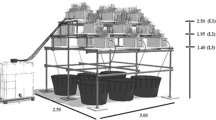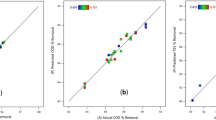Abstract
In the present study, the Taguchi design (TD) and the Box-Behnken design (BBD) were used to determine the effect of surfactant concentration, flushing velocity, and dense non-aqueous-phase liquid–trichloroethylene (DNAPL TCE) mass on the time of remediation for the removal of DNAPL zones, which is one of the main persistent sources of groundwater pollution. In the Taguchi approach, the performance of the response variable is measured based on the signal-to-noise (S/N) ratio whereas estimation of the full quadratic model of the parameters is allowed in the Box-Behnken design. The mean experimental values ranged between 3.97–8.31 and 4.01–9.70 for BBD and TD, respectively. Surfactant concentration was identified as the most significant parameter contributing to remediation efficiency in both design techniques. Minimum remediation effort was determined as 5.99 at obtained optimal conditions of surfactant concentration (2.5%), flushing rate (6 cm/h), and DNAPL TCE mass (365 mg) using BBD. In the case of TD, the optimal conditions were determined at a surfactant concentration of 10%, 2 cm/h flushing rate, and 365 mg DNAPL TCE mass. Analysis of variance (ANOVA) revealed a good relationship between the predicted and experimental values with 1.96% and 0.31% of the total variation that was not explained by the model using TD and BBD, respectively. Consequently, from this comparative study, it was concluded that BBD was a more suitable alternative to TD for the evaluation of remediation of DNAPL-contaminated sites.







Similar content being viewed by others
References
Akyol, N. H. (2018). Surfactant-enhanced permanganate oxidation on mass-flux reduction and mass removal relationship for pool-dominated TCE source zones in heterogeneous porous media. Water, Air, and Soil Pollution, 229, 285.
Akyol, N. H., & Turkkan, S. (2018). Effect of cyclodextrin-enhanced dissolution on mass removal and mass-flux reduction relationships for non-uniformly organic liquid distribution in heterogeneous porous media. Water, Air, & Soil Pollution, 229, 30.
Akyol, N. H., Lee, A. R., & Brusseau, M. L. (2013). Impact of enhanced-flushing reagents and organic liquid distribution on mass removal and mass discharge reduction. Water, Air, and Soil Pollution, 224, 1731.
Anwar, M., Rasul, M. G., & Ashwath, N. (2018). Production optimization and quality assessment of papaya (Carica papaya) biodiesel with response surface methodology. Energy Conversion and Management, 156, 103–112.
Arslan, A., Topkaya, E., Bingol, D., & Veli, S. (2018). Removal of anionic surfactant sodium dodecyl sulfate from aqueous solutions by O3/UV/H2O2 advanced oxidation process: process optimization with response surface methodology approach. Sustainable Environment Research, 28(2), 65–71.
Betiku, E., & Taiwo, A. E. (2015). Modeling and optimization of bioethanol production from breadfruit starch hydrolyzate vis-a-vis response surface methodology and artificial neural network. Renewable Energy, 74, 87–94.
Bezerra, M. A., Santelli, R. E., Oliveiraa, E. P., Villar, L. S., & Escaleiraa, L. A. (2008). Response surface methodology (RSM) as a tool for optimization in analytical chemistry. Talanta, 76, 965–977.
Boving, T. B., & Brusseau, M. L. (2000). Solubilization and removal of residual trichloroethene from porous media: comparison of several solubilization agents. Journal of Contaminant Hydrology, 42, 51–67.
Carroll, K. C., & Brusseau, M. L. (2009). Dissolution, cyclodextrin-enhanced solubilization, and mass removal of an ideal multicomponent organic liquid. Journal of Contaminant Hydrology, 106(1–2), 62–72.
DiFilippo, E. L., & Brusseau, M. L. (2008). Relationship between mass flux reduction and source zone mass removal: analysis of field data. Journal of Contaminant Hydrology, 98(1–2), 22–35.
Difilippo, E. L., Carroll, K. C., & Brusseau, M. L. (2010). Impact of organic-liquid distribution and flow-field heterogeneity on reductions in mass flux. Journal of Contaminant Hydrology, 115, 14–25.
Esfandiar, N., Nasernejad, B., & Ebadi, T. (2014). Removal of Mn(II) from groundwater by sugarcane bagasse and activated carbon (a comparative study): application of response surface methodology (RSM). Journal of Industrial and Engineering Chemistry, 20, 3726–3736.
Harvell, J.R. (2012) Solubilization of multi-component immiscible liquids in homogeneous systems: a comparison of different flushing agents using a 2-D flow-cell. The University of Alabama M.S Thesis at Geological Science Department.
Ido, A. L., Luna, M. D. G., Capareda, S. C., Maglinao, A. L., Jr., & Nam, H. (2018). Application of central composite design in the optimization of lipid yield from Scenedesmus obliquus microalgae by ultrasonic-assisted solvent extraction. Energy, 157, 949–956.
Khodaei, K., Nassery, H. R., Asadi, M. M., Mohammadzadeh, H., & Mahmoodlu, M. G. (2017). BTEX biodegradation in contaminated groundwater using a novel strain (Pseudomonas sp. BTEX-30). International Biodeterioration & Biodegradation, 116, 2134–2242.
Kilavuz, S. A., & Akyol, N. H. (2018). TCE Kaynak Zonların Yerinde Kimyasal Yıkama ile Islahı: Tween 80 ve SDS ile Yıkama Performansı. Dokuz Eylul Üniversity-Faculty of Engineering. Journal of Science and Engineering, 20(58), 197–208.
Mahal, M. K., Murao, A., Johnson, G. R., Russo, A., & Brusseau, M. L. (2010). Non-ideal behavior during complete dissolution of organic immiscible liquid: 2. Ideal porous media. Water, Air, and Soil Pollution, 213, 191–197.
Martínez-Villafane, J. F., & Montero-Ocampo, C. (2010). Optimisation of energy consumption in arsenic electro-removal from groundwater by the Taguchi method. Separation and Purification Technology, 70, 302–305.
McCray, J. E., & Brusseau, M. L. (1999). Cyclodextrin-enhanced in situ flushing of multiple-component immiscible organic liquid contamination at the field scale: analysis of dissolution behavior. Environmental Science & Technology, 33(1), 89–95.
Moosavi, V., Vafakhah, M., Shirmohammadi, B., & Ranjbar, M. (2014). Optimization of wavelet-ANFIS and wavelet-ANN hybrid models by Taguchi method for groundwater level forecasting. Arabian Journal for Science and Engineering, 39, 1785–1796.
Mutala, M., Ismail, O., Aykan, K., & Augustine, D. (2018). Effect of waste matrix for the optimization of moisture content and calorific value of bio-dried material using Taguchi DOE. Drying Technology. https://doi.org/10.1080/07373937.2018.1500484.
Özdemir, U., Özbay, B., Özbay, İ., & Veli, S. (2014). Application of Taguchi L32 orthogonal array design to optimize copper biosorption by using Sphagnum moss. Ecotoxicology and Environmental Safety, 107, 229–235.
Prasad, K. S., Rao, S., & Rao, N. (2012). Application of design of experiments to plasma arc welding process: a review. Journal of the Brazilian Society of Mechanical Sciences and Engineering, 34, 75–81.
Rosa, J. L., Robin, A., Silva, M. B., Baldan, C. A., & Peres, M. P. (2009). Electrodeposition of copper on titanium wires: Taguchi experimental design approach. Journal of Materials Processing Technology, 209, 1181–1188.
Russo, A., Mahal, M. K., & Brusseau, M. L. (2009). Nonideal behavior during complete dissolution of organic immiscible liquid: 1. Natural porous media. Journal of Hazardous Materials, 172, 208–213.
Taguchi, G., Chowdhury, S., & Wu, Y. (2005). Taguchi’s quality engineering handbook. Livonia: ASI Consulting Group, LLC.
Tarley, C. R. T., Silveira, G., dos Santos, W. N. L., Matos, G. D., da Silva, E. G. P., Marcos Almeida Bezerra, M. A., Miró, M., & Ferreira, S. L. C. (2009). Chemometric tools in electroanalytical chemistry: methods for optimization based on factorial design and response surface methodology. Microchemical Journal, 92, 58–67.
Tick, G. R., & Rincon, E. (2009). Effect of enhanced solubilization agents on dissolution and mass flux from uniformly distributed immiscible liquid trichloroethylene (TCE) in homogeneous porous media. Water, Air, and Soil Pollution, 204, 315–332.
Tick, G. R., Lourenso, F., Wood, A. L., & Brusseau, M. L. (2003). Pilot-scale demonstration of cyclodextrin as a solubility-enhancement agent for the remediation of a tetrachloroethene-contaminated aquifer. Environmental Science & Technology, 37, 5829–5834.
Tick, G. R., Harvell, J. R., & Murgulet, D. (2015). Intermediate-scale investigation of enhanced-solubilization agents on the dissolution and removal of a multicomponent dense non-aqueous phase liquid (DNAPL) source. Water, Air, and Soil Pollution, 226, 371.
Wantala, K., Khongkasem, E., Khlongkarnpanich, N., Sthiannopkao, S., & Kim, K. W. (2012). Optimization of As(V) adsorption on Fe-RH-MCM-41-immobilized GAC using Box–Behnken design: effects of pH, loadings, and initial concentrations. Applied Geochemistry, 27, 1027–1034.
Acknowledgments
This study was funded by TUBİTAK 115Y117. The authors would like to show their appreciation to Dr. Mutala Mohammed for his immense contribution to the optimization analysis.
Author information
Authors and Affiliations
Corresponding author
Additional information
Publisher’s Note
Springer Nature remains neutral with regard to jurisdictional claims in published maps and institutional affiliations.
Rights and permissions
About this article
Cite this article
Mohammed, M., Ozbay, I., Akyol, G. et al. Optimizing Process Parameters on the Remediation Efforts for the Mass Removal of DNAPL Entrapped in a Porous Media. Water Air Soil Pollut 230, 161 (2019). https://doi.org/10.1007/s11270-019-4191-0
Received:
Accepted:
Published:
DOI: https://doi.org/10.1007/s11270-019-4191-0




